Kyoto, Japan is one of the most photogenic cities I’ve visited. As the former capital city of Imperial Japan, it has a rich history; and with mountain ranges on three sides and a river bisecting the city, the scenery is also attractive.
Album 1: All Photos
I took nearly four hundred photos during two trips to the city, so I have I have divided the photos into different albums. If you want to see everything, click on the following photo or link.

View Album: Kyoto; All Photos (394 photos)
Album 2: Chion-ji Handicraft Market, Shimogamo Shrine, Tadasu no Mori

2.1 Chion-ji Handicraft Market (百万遍さんの手づくり市)
On the 15th of each month there is a local handicraft market (Chion-ji Tezukuri-ichi) at Chion-ji temple (知恩寺). There are around a hundred stalls around the temple, with vendors selling goods such as jewelry, dolls), clothing, kitchenware, rattan baskets, artwork, hand-carved boxes and homemade pastries. This is a good place to buy souvenirs and support local artisans and artists (I got some postcards). Unfortunately, shortly after I took these photos, a sudden storm blew in. Everything got soaked in the heavy downpour. Everyone waited out the rain under the eaves of the temple buildings, but once the skies cleared, most of the visitors left and the vendors started packing up.



2.2 Shimogamo Jinja (下鴨神社)
Shimogamo Shrine is situated on an island at the fork of the of the Kamo and Takano rivers and is one of Japan’s oldest Shinto shrines. When I was there, the shrine was hosting a light festival designed by Teamlab. I’ve described the two-part exhibition in more detail in an article on my art blog: Light Festival at Tadasu no Mori and Shimogamo-jinja.
I hadn’t planned on visiting the shrine, but after the heavy rainfall cut short my visit to the handicraft market, I had some time on my hands and decided to check it out. While there, I saw the poster for the light festival and returned two days later to see it.
The installation consisted of two parts. The first part was called ‘Resonating Trees’. In the forest of Tadasu no Mori (糺の森), along the path leading to the shrine. the trees were lit up, with the colors changing according to the movement of people nearby (and also the changes in the neighboring lights).


The second part of the installation was in the grounds of the shrine and was called ‘Resonating Spheres’. It consisted of illuminated floating spheres that changed color depending on the proximity of visitors and also on the color changes going on in neighboring spheres.



Shimogamo Shrine is a main setting in the highly popular anime series Uchouten Kazoku (the Eccentric Family). It is where the protagonist, Yasaburō, lives with his tanuki family.




2.3 Second-hand Book Market in Tadasu no Mori (下鴨納涼古本まつり)
To get to the shrine, you walk though a primeval forest known as Tadasu no Mori (糺の森, which means ‘Forest of Correction’). Many of the trees in the forest are between 200 and 600 years old. It is said that any lies told within the forest will be exposed.
In Tadasu no Mori, there is an annual used book fair— the Shimogamo Noryo Furuhon Matsuri. A book market in a mythical forest! That’s something you don’t see every day. While people were browsing for books and manga, some children were playing in a stream while other kids were watching a book-reading performance
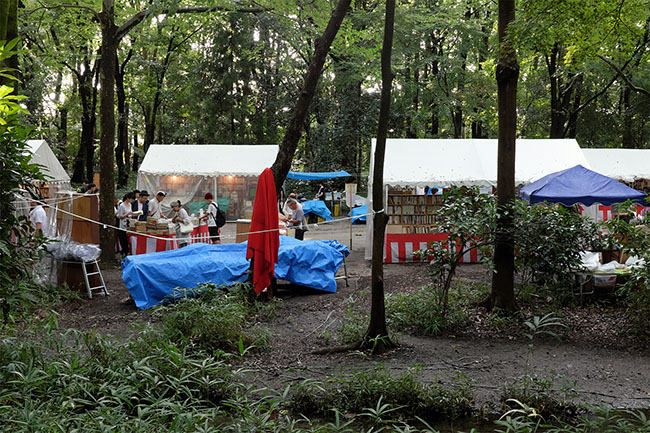



The used book market appears as a setting in the anime Night is Short, Walk on Girl:

View Album 2: Chion-ji Handicrafts Market, Shimogamo Shrine, Tadasu no Mori (88 photos)
Album 3: Fushimi Inari Taisha & Tofuku-ji

3.1 Fushimi Inari Taisha (伏見稲荷大社)
Fushimi Inari Taisha features thousands of vermilion torii gates snaking up a forested hillside. It is conveniently located just a couple of stops south of the main Kyoto train station, and its uniqueness makes it a must-see site if you are vising Kyoto. The shrine complex is dedicated to Inari, the Shinto god of rice.
Torii are gates that mark the transition from the ordinary world to the sacred one, so you can often see them outside temples and shrines in Japan.
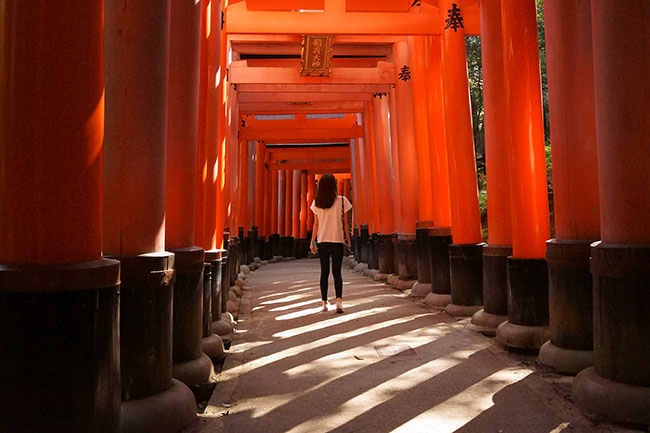
On one side of many of the torii is Japanese script in black ink. Thee text names sponsors (individuals or businesses) and the date that their sponsorship started.

Along the trails and in the smaller shrines, you will often see statues of Kitsune (fox spirits), which are thought to be messengers of Inari.
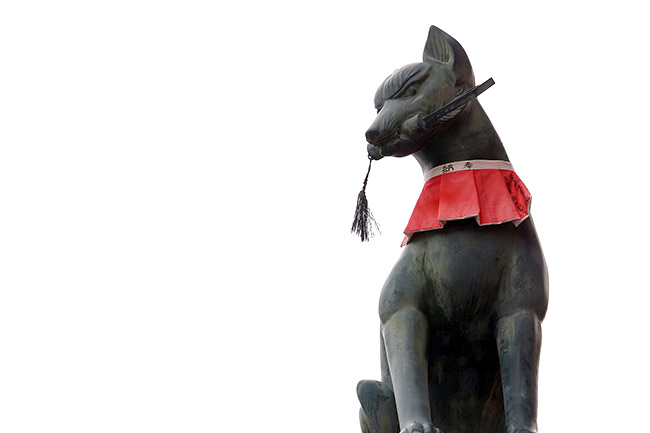

There are different places for making wishes. Outside the main shrine complex, for example, is a board for writing wishes on fox-head-shaped wooden prayer tablets. Further up the hillside, there is a small shrine where you can write wishes inside tiny origami outfits known as Kanae-Bina.

The rope in the following picture is called a shimenawa (which literally means ‘enclosing rope’). Shimenawa are used to indicate a sacred or pure place and to ward off evil spirits. You can see shimenawa at various points along the trail.

As you progress up the hillside, the torii become more spaced-out, and you will also pass through a bamboo grove. On the other side of the hill, the moss-covered tombstones and kitsune statues create a spooky atmosphere. Eventually, you end up on a forest part which leads to a suburban street close to Tofuki-ji.


Fushimi Inari Taisha is a main setting in the anime Inari, Konkon, Koi Iroha.

3.2 Tofuki-ji (東福寺): Not far from the north exit of Fushimi Inari Taisha is Tofuki-ji, a thirteenth century temple. This temple is best visited in autumn, when the leaves change color. It has viewing platforms and balconies for this purpose.

View Album 3: Fushimi Inashi Taisha & Tofuku-ji (77 photos)
Album 4: Arashiyama

Arashiyama is located in the west part of Kyoto at the foot of the Arashiyama Mountains. There are many tourist attractions there, with two of the most important ones being the bamboo grove and Tenryu-ji.
4.1 Arashiyama Bamboo Grove: This is just what the name says it is—a large bamboo forest. There is a 500-metre path through the grove.

4.2 Tenryu-ji (天龍寺): Nearby is Tenryu-ji, a large zen temple.
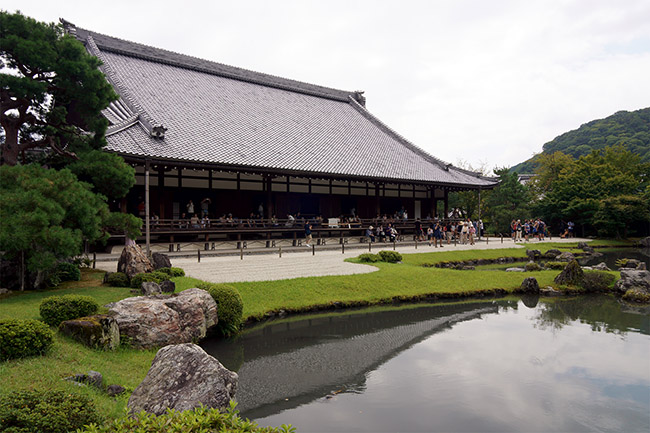
4.3 Floating Lantern Ceremony: In mid-August in Kyoto, the annual Obon festival— a major festival for remembering and honoring one’s ancestors—is celebrated. It is normally held around the 15th of August, but the exact date is based on the lunar calendar and changes from year to year. On the night of Obon there is a lantern floating ceremony on the Katsura river by Arashiyama. Family members use the lanterns—known as toro nagashi—to symbolically send off their ancestors. On the river bank, the atmosphere is quite festive, with food stalls selling things like corn on the cob, dumplings and candied apples.




View Album 4: Arashiyama (29 photos)
Album 5: Ohara

Ohara (大原) is a farming village about an hour by bus north of Kyoto. It is famous for its temples and shrines. I visited three of them: Hosen-in. Sanzen-in and Jakko-in.
5.1 Hosen-in (宝泉院): At Hosen-in you can drink green tea, admire a beautiful and ancient gnarled pine tree and contemplate your existence all the while sitting beneath a ceiling stained with the blood of fallen warriors. The ceiling is made up of floorboards from Fushimi Castle, where the last defenders loyal to Ieyasu Tokugawa, committed ritual suicide when the castle was taken in 1600.

5.2 Sanzen-in (三千院): The temple of Sanzen-in is the main attraction in Ohara and is famous for its beautiful garden. In the garden, you may notice ceramic Jizo figurines. Jizo Bosatsu is the guardian deity of children and travelers.


5.3 Jakko-in (寂光院): This is another temple associated with a tragic story. Jakko-in is the convent where the Empress Dowager Dowager Kenrei-mon In retreated to after the sea battle of Dan-no-ura, which she managed to survive, but only after the loss of her child and all of her immediate family

View Album 5: Ohara (39 photos)
Album 6: Gion & Higashiyama

These two adjacent districts are probably the most famous areas in Kyoto, and are renowned for their traditional architecture and culture. Gion is also well known for its nightlife. I didn’t spend long exploring this area, so I will have to spend more time there on my next visit to the city.
6.1 Yasaka Koshindo Temple (八坂庚申堂)
Yasaka Koshindo Temple is a small but really colorful temple in Gion. Temple-goers can write their wishes on a fabric balls called ‘kukurizaru’ and hang the up with the other balls. It is believed that if you give up one of your desires, one of your wishes may come true.

6.2 Yasaka Pagoda (八坂の塔)
This elegant structure, more formally know as Hokan-ji, is one of Kyoto’s main landmarks.

6.3 Yasaka Shrine, Maruyama Park and Otani Cemetery
Yasaka Shrine (八坂神社), also known as Gion shrine, is one of Kyoto’s oldest shrines, dating back to the 7th century. Behind the shrine is Maruyama Park (円山公園). If you are in Kyoto in early April, you should go to the park to see cherry blossoms. I went there at night during Obon (in the summer), and all the paths were lit up with lanterns, many of which had been hand-painted by children. Following the lanterns through Maruyama park, I ended up at Otani Cemetery. During Obon, families place lit lanterns on the graves of their ancestors. Lanterns dotted the hillside of Otani Cemetery like stars in the sky.



6.4 Nanzen-ji (南禅寺)
Nanzen Ji is a large temple complex in Higashiyama. The picture at the top of this article was taken there. Near the temple is an old stone aqueduct (shown below).

6.5 The Philosopher’s Path (哲学の道)
The Philosopher’s Path is a path stone path beside a canal. It is a nice place for a stroll. The path was named because a famous philosopher, Nishida Kitaro, was said to practice meditation while walking on the path during his daily commute to Kyoto University.


6.6. The Studio Ghibli store
If you are anime fan, make sure to visit the Studio Ghibli store in Gion.

View Album 6: Gion & Higashiyama (44 photos)
Album 7: North of Kyoto

This album includes photos taken during two hikes north of Kyoto, so there is a lot of I scenery and some picturesque shrines and temples.
7.1 Kurama (鞍馬) to Kibune (貴船)
These are two small towns north of Kyoto. They are in valleys separated by a small mountain. Kurama-Dera (鞍馬寺) is a temple offering good views. Once past the temple, there is a spooky area known as Kinone-sando. In this area, many of the the tree roots are exposed. Then there is a downhill walk to Kibune, which has its own shrine and which is famous for its riverside restaurants.








7.2 Kinkaku-ji (金閣寺) to Jingo-ji (神護寺)
I started at Kinkaku-ji (the Golden Pavilion ) and wandered around the hills northwest of Kyoto. Unfortunately, I didn’t get any great pictures of Kinkaku-ji. It was overcast when I was there and to really appreciate the temple in all of its glory, you would want to see sunlight glittering on the temple’s golden walls and eaves.
The last place I visited during that hike was Jingo-ji. At this temple, you can buy small clay discs that represent your misfortune and hurl them into the valley below. It felt good to do that.






View Album 7: North of Kyoto (44 photos)
Album 8: Ponto-chō, Kamogawa, Ichihime Shrine, Nishiki Market, Kitano-tenman-gu

This album focuses on the area across the Kamo River from Gion. This area is heavily featured in the anime Uchouten Kazoku:




8.1 Kamo-gawa (鴨川) & Ponto-chō (先斗町)
The Kamo River is worth a visit. People come here on weekends, after work or after school to hang out (or even do things like practise playing trombone). Just beside the river is the narrow alley of Ponto-chō, famed for its exclusive restaurants.





8.2 Nishiki Market (錦市場)
Nishiki Market is a famous shopping arcade specializing in food.

8.3 Ichihime Shrine (市比賣神社)
Ichihime Shrine is one of many small shrines in Kyoto. This one mainly focuses on the protection of women and uses daruma dolls for fortune telling (there is a fortune inside each of the Princess Daruma dolls).


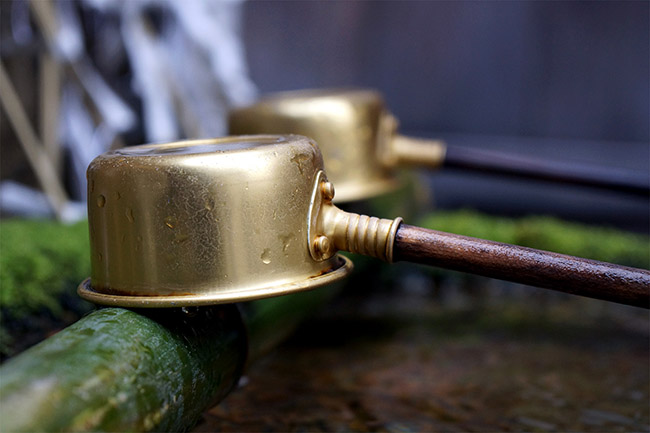
Kitano-tenman-gu (北野天満宮)
Kitano-tenman-gu is a temple with a bi-monthly market and fair—Tenjin-san Market. Ringing the bell at Kitano-tenman-gu is said to dispel ominous presences. At the market you can buy snacks and household items and children can play stall games.






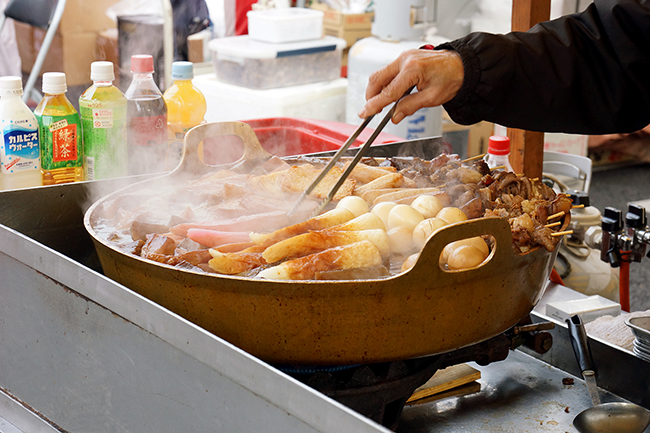

View Album 8: Ponto-chō, Kamogawa, Ichihime Shrine, Nishiki Market, Kitano-tenman-gu (64 photos)
Album 9: Osaka & Nara

9.1 Nara (奈良市)
A short train ride from Kyoto is the small city of Nara, which is famous for its Sika deer. Sika deer from this area have long been protected, first as sacred animals and then as national treasures. There are over a thousand deer roaming around the park.

9.2 Osaka
I just spent one day in Osaka, so the photo album is quite small. It features views of the city, Osaka Castle, the obligatory shot of the Glica billboard and shots of a rock band doing a promotional performance.





Here is a short time-lapse video I made showing the Osaka skyline
View Album 9: Osaka & Nara (47 photos)
What I didn’t see
Quite often when I travel, I am looking to get away from the crowds (as I live in ultra-densely-populated Hong Kong), so sometimes I will skip top attractions and spend the time at places that are a little out of the way. Consequently, I still haven’t been to some of Kyoto’s most famous landmarks: the temples Kiyomizu-dera and Ginkaku-ji as well as Nijō Castle and Kyoto Imperial Palace. I’ll check them out when I revisit the city in future.


[…] I shot the photos of footage of Osaka in 2016 from my hotel room as the sun started to set. The camera I was using—a Sony NEX-7—doesn’t have an automatic timer, but it does have a time delay setting (e.g., the shutter will release a set time after pressing the button), so I had to press the shutter button for each photo. To see more of my photos from that trip (to Kyoto, Osaka and Nara), you can go to my article: Kyoto Photos. […]